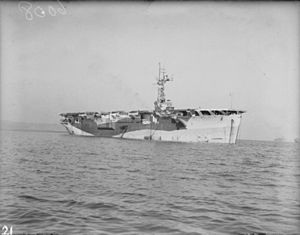HMS Campania (D48)

HMS Campania
|
|
| History | |
|---|---|
|
|
|
| Builder: | Harland and Wolff |
| Yard number: | 1091 |
| Laid down: | 12 August 1941 |
| Launched: | 17 June 1943 |
| Completed: | 7 March 1944 |
| Commissioned: | 9 February 1944 |
| Decommissioned: | 30 December 1945 |
| Commissioned: | 1952 |
| Decommissioned: | December 1952 |
| Identification: | Pennant number: D48 |
| Fate: | Scrapped 1955 |
| General characteristics | |
| Class and type: | Nairana-class escort carrier |
| Displacement: |
|
| Length: | 540 ft (160 m) |
| Beam: | 70 ft (21 m) |
| Draught: | 22.8 ft (6.9 m) |
| Propulsion: | Two shafted diesel engines, 13,250 shp |
| Speed: | 18 knots (33 km/h) |
| Range: | 17,000 nautical miles (31,000 km) at 17 knots (31 km/h) |
| Complement: | 639 |
| Armament: |
|
| Aircraft carried: | 18 |
HMS Campania was an escort aircraft carrier of the Royal Navy that saw service during the Second World War. After the war, the ship was used as a floating exhibition hall for the 1951 Festival of Britain and as the command ship for the 1952 Operation Hurricane, the test of the prototype British atomic bomb.
She was built at Harland & Wolff shipyards in Belfast, Northern Ireland. When construction started in 1941 she was intended as a refrigerated cargo ship for transporting lamb and mutton from New Zealand, but was requisitioned by the British Government during construction and completed and launched as an escort carrier, entering service in early 1944.
The ship was of a similar, but not identical design to the other ships of the Nairana class.
Campania operated escorting convoys and doing anti-submarine work in the Atlantic and Arctic theatres. In December 1944, her Swordfish aircraft from a detachment of 813 Squadron sank the German submarine U-365 while the Campania was escorting the Arctic convoy Convoy RA-62.
The ship survived the war, and unlike other Royal Navy escort carriers, was not immediately scrapped or sold. She was briefly used as an aircraft transport before being decommissioned and placed in reserve in December 1945.
In 1951, she was the Festival of Britain's exhibition ship, touring the country's ports with a civilian crew as the Festival Ship Campania to supplement the main exhibition in London and two thousand local events.
...
Wikipedia
